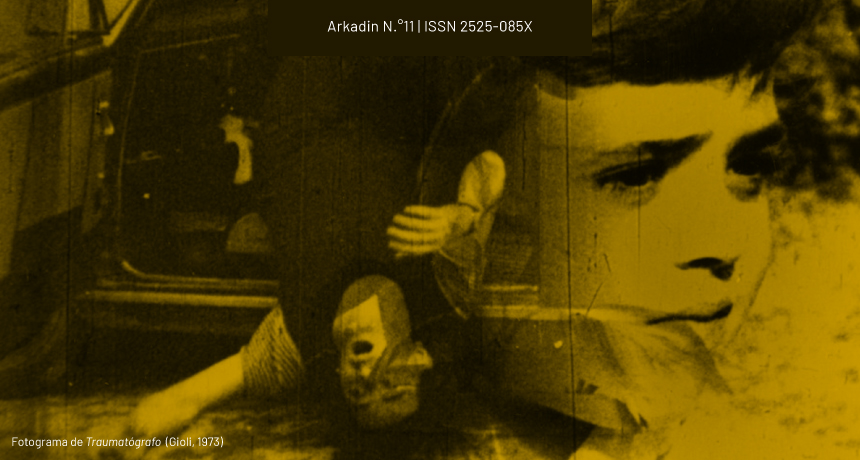El cine de Paolo Gioli: huellas, temblores, metamorfosis
Paolo Gioli’s Cinema: Traces, Tremors, Metamorphosis
DOI:
https://doi.org/10.24215/2525085Xe038Keywords:
Film, experimental, avant-garde, photography, visionAbstract
This article examines various aspects of the poetics of Paolo Gioli (1942-2022), an integral artist who crossed painting, lithography, photography, film and video, challenging the boundaries and definitions of each media. Gioli proposes a cinema that contests the technologies of the image and interrogates the foundations of cinema. The relationships between body and gaze, between representation and abstraction, as well as the articulations between different modes of images in the audiovisual experience have been subjected in his work to an incessant battle in the field opened by the screen.References
Bullot, Eric (2010). Pulsione, pulsazione. Catalogo dell 8° edizione del Lucca Film Festival. Lo schermo inciso-Venti film di Paolo Gioli. Lucca Film Festival. http://www.paologioli.it/download/Pulsion_pulsation_it.pdf
Bordwell, D (2009). Paolo Gioli’s Vertical Cinema. David Bordwell’s Website on Cinema. https://www.davidbordwell.net/essays/gioli.php
Bordwell, D (19 de abril de 2016). Paolo Gioli, maximal minimalist. Observations on film art. http://www.davidbordwell.net/blog
Di Marino, B. (2015). Laboratorio Gioli. RaroVideo/Interferenze.
Dubois, P. y A. Somaini (comp.) (2020). Paolo Gioli. Impressions sauvages. Presses du Réel.
Fragapane, G. D. (2009). The paradoxical cinema of Paolo Gioli, en Fragapane, G.D. (a cura di) Catálogo Omaggio a Paolo Gioli, 45° Mostra Internazionale del Nuovo Cinema. Ed. Fondazione CCC.
Fragapane, G. D. (2020). Paolo Gioli. Cronologie. Johan & Levi.
Gioli, P. (1974). Scritti per un rettangolo bianco. Bianco e Nero, # 5-8. En paologioli.it http://www.paologioli.it/download/scritti_rettangolo_bianco.pdf
Gioli, P. (2006). I Film di Paolo Gioli. (2 DVD). Kiwido-Centro Sperimentale de Cinema.
Gioli, P. (2009). Il Cinema della Impronta (DVD). Kiwido-Centro Sperimentale de Cinematografía.
Gioli, P. (2015). Tutto il Cinema di Paolo Gioli (3 DVD). RaroVideo.
Rumble, P. (2014). Persistence of Vision.The Films of Paolo Gioli. Art Forum. (54) #10.
Rumble, P. (2015). Free Films Made Freely [Documental]. En P. Gioli, Tutto il Cinema di Paolo Gioli.
Testa, B. (2010). The Unstable Eye: Paolo Gioli’s Film Practice Seen through Paul Virilio. Incite, (2). https://inciteonline.net/testa2.html
Toffetti, S.; Licciardello, A. (2009). Il cinema della impronta. Centro Sperim. Cinematografia.
Downloads
Published
How to Cite
Issue
Section
License

This work is licensed under a Creative Commons Attribution-NonCommercial-ShareAlike 4.0 International License.
The acceptance of the manuscript by the magazine means the non-exclusive cession of the property rights of the authors in favour of the editor, who allows the reuse, after publication (post print), under a license Attribution-NonCommercial-NoDerivatives 4.0 International.
According to these terms, the material can be copied and redistributed by any means or in any format as long as a) the author and original source of the publication are quoted (magazine and URL of the work), access to the license is provided and whether changes have been made is mentioned; and b) the material is not used for commercial purposes.
The cession of non-exclusive rights means that after the publication (post print) in Arkadin the authors can publish their work in any language, means and format; in such cases it must be mentioned that the material was originally published in this magazine. Such cession also means the authorization of the authors for the work to be collected by SEDICI, the institutional archive of the Universidad Nacional de La Plata, and to be spread in the databases that the editorial team considers appropriate to increase the visibility of the publication and its authors.
Moreover, the magazine encourages the authors to deposit their productions in other institutional and thematic archives under the principle that offering the society the scientific and academic production without any restrictions contributes to a greater exchange of the global knowledge.
























